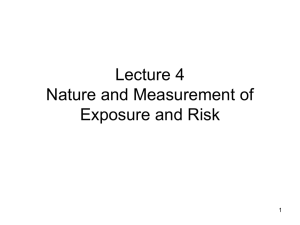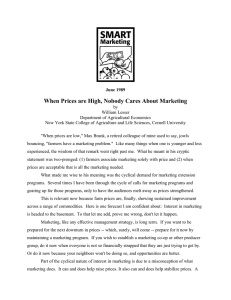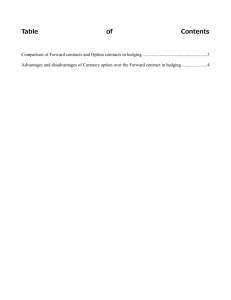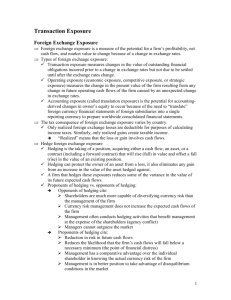International Financial Management Chapter 4 Hedging foreign exchange risk Michael Connolly
advertisement
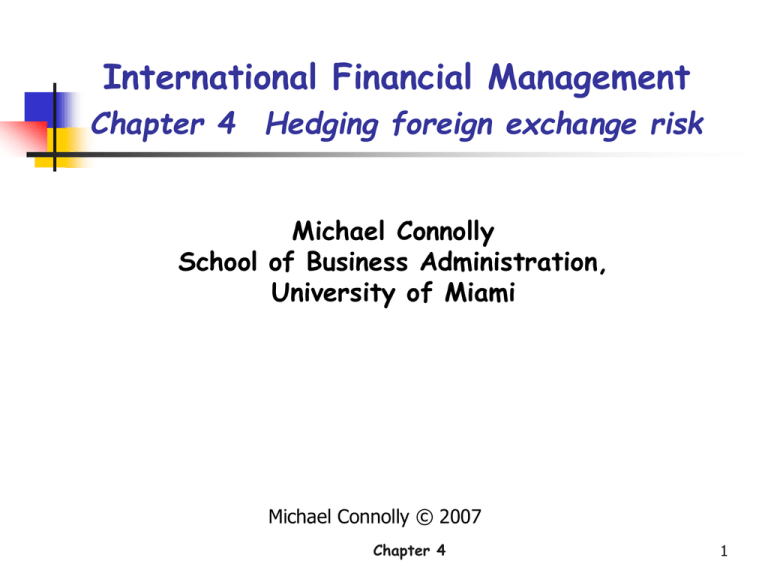
International Financial Management Chapter 4 Hedging foreign exchange risk Michael Connolly School of Business Administration, University of Miami Michael Connolly © 2007 Chapter 4 1 To hedge or not to hedge? Investors can, in principle, perform any foreign exchange hedging that the corporation can. Consequently, the corporation need not devote resources to the elimination of diversifiable or hedgeable risk. Indeed, hedging might be counterproductive by harming the interests of shareholders. Chapter 4 Page 2 To hedge or not to hedge? Similarly, a firm which takes over other firms in different industries might displease shareholders who can diversify their portfolio directly by purchasing shares themselves in those industries. Chapter 4 Page 3 To hedge or not to hedge? When there are neither transactions costs, nor bankruptcy costs, shareholders with perfect information can undertake any hedging they feel necessary. In short, a cogent argument can be made that the firm should not hedge foreign exchange risk - exposure to unexpected changes in the exchange rate. However, the majority of international firms hedge foreign exchange risk selectively, if not completely. Chapter 4 Page 4 To hedge or not to hedge? A counterargument in favor of FOREX hedging is made by Ian Giddy*: Exchange-rate volatility may make earnings volatile and thus increase the probability of financial distress. If hedging reduces the nominal volatility of the firm's earnings, it will in turn reduce the expected value of the costs of financial distress (including bankruptcy) ... Some of these costs are borne by creditors, in which case a reduction in expected distress costs will reduce lenders’ required rate of return. … Chapter 4 Page 5 To hedge or not to hedge? In addition, for a given level of debt, lower earnings volatility will entail a lower probability of a negative net worth. … Because currency matching reduces the probability of financial distress, it allows the firm to have greater leverage and therefore a greater tax shield. Thus, the greater the degree of bankruptcy-costhedging, the greater the value of the firm and the lower the cost of capital.(pp. 4812). *Source: Ian H. Giddy, Global Financial Markets, © DC Heath and Company 1994, pp. 481-2. Chapter 4 Page 6 To hedge or not to hedge? Thus, in comparison to the unhedged firm, the reduced costs of financial distress and the lowered borrowing costs may offset the costs of the hedges. Another way of putting the argument is that hedging reduces the market risk of a company. By hedging, a company’s b is lower so its risk premium is lower. Thus the firm’s expected net earnings would be discounted at a lower interest rate. However, expected earnings are reduced due to the costs of the hedges. Its net worth could be higher or lower. Chapter 4 Page 7 To hedge or not to hedge? The cost of hedging (according to Giddy). Hedging reduces the risk of bankruptcy and financial distress, but is likely to reduce the value of the firm by [Vu – Vh], the cost of hedging. Chapter 4 Page 8 Hedging foreign exchange risk Hedging defined: A firm or an individual hedges by taking a position, such as acquiring a cash flow, an asset or a contract, that will rise (or fall) in value to offset a fall (or rise) in the value of an existing position. A perfect hedge is one eliminating the possibility of future gain or loss due to unexpected changes in the value of the existing position. Chapter 4 Page 9 Transactions exposure A long position: When a firm has accounts receivable in foreign exchange at some time in the future, it is exposed to transactions exposure - losses or gains due to unexpected changes in the exchange rate. Chapter 4 Page 10 Transactions exposure The payoff from an unhedged long position, say accounts receivable in 90 days in euros. The expected exchange rate (pound price of the euro) in 90 days is given by F90, In 90 days, we will realize a spot rate, S90. Consequently, the unanticipated change in the exchange rate or forecast error is indicated by: [F90 - S90] This represents the gain (if positive) or the loss (if negative) per unit of the euro in which the firm has long foreign exchange exposure. Chapter 4 Page 11 Transaction exposure If the firm is long 100,000 euros (accounts receivable, for example) the unhedged firm gains if the spot price of the euro is above the forward price upon receipt of the euros. Payoff diagram for accounts receivable (a long position in foreign exchange) An unanticipated gain Chapter 4 Page 12 Transaction exposure If the spot price is less than the forward, the firm will lose: [F90 - S90] 100,000 pounds. Payoff diagram for accounts receivable (a long position in foreign exchange) An unanticipated loss Chapter 4 Page 13 Transactions exposure If you are short euros (accounts payable, for example), you will lose [F90 - S90] 100,000 pounds if the spot price is higher. Payoff diagram for accounts payable (a short position in foreign exchange) An unanticipated loss Chapter 4 Page 14 Transaction exposure If the spot price is lower, you will gain by not being hedged. Payoff diagram for accounts payable (a short position in foreign exchange) An unanticipated gain Chapter 4 Page 15 Transaction exposure Example: You are the owner of FU YANG FLYING EAGLE DUMPLINGS and have sold $100,000 worth of rice dumplings (zongzi) to a Chinese restaurant in San Francisco. You will be paid $100,000 in 90 days. Assume that the current spot exchange rate is 8.2767 yuan to the dollar. There is some risk that you may suffer a loss if you do not sell the accounts receivable in the forward market. Suppose, for example that the IMF and the US Treasury accomplish their goals of a yuan appreciation. You will lose in terms of yuan, should you not hedge. Chapter 4 Page 16 Transaction exposure Here is the payoff diagram assuming a 10% revaluation of the yuan. The unanticipated revaluation of the yuan has reduced the yuan value of your accounts receivable by -0.8267 yuan per dollar. Since you receive $100,000 in 90 days, their new value in yuan are only 7.45*100,000=745,000 yuan. In other words, you have lost (8.2767-7.4500)*100,000= 82,670 yuan. Chapter 4 Page 17 Transaction exposure An unexpected devaluation of the yuan, for example due to capital account liberalization, may increase the yuan value of your accounts receivable by 1.000 yuan per dollar. Since you receive $100,000 in 90 days, their new value in yuan are 9.28*100,000 =928,000 yuan. In other words, you might unexpectedly gain as depicted in the payoff diagram. Chapter 4 Page 18 Hedging transaction exposure Hedging FOREX exposure eliminates both the risk of losses, and the chance of gains from unexpected movements in the exchange rate. There are several contractual hedges you may consider. A forward hedge A money market hedge An options hedge Here we ignore the transactions costs of the hedge, which are the commission on the forward sale and the receiving of the “bid” price of the dollar, which is lower than the “ask” Chapter 4 Page 19 Hedging transaction exposure 1. A forward market hedge – Sell the $100,000 forward for delivery at F90 , or 8.2767. When you receive the accounts payable, deliver the $100,000 to settle your forward contract. If you sell the entire amount of your accounts receivable, you have a “perfect hedge” that eliminates all possibility of gain or loss from an unexpected change in the exchange rate. Chapter 4 Page 20 Hedging transaction exposure 1. A forward market hedge With a perfect hedge in the forward market you lose on one contract what you gain on the other. If the spot rate falls to 7.45 in 90 days, you lose 0.83 yuan per dollar of accounts receivable, but you gain 0.83 yuan per dollar on the forward sale contract. Chapter 4 Page 21 Hedging transaction exposure 2. A money market hedge – Borrow [$100,000/(1+ i/4)] to be repaid in 90 days. To settle the loan, you will pay interest and principal of exactly $100,000 from your receipt of accounts payable in 90 days. Chapter 4 Page 22 Hedging transaction exposure A money market hedge example: Borrow at 12% per annum for 90 days, a quarterly rate of 4%. That is, borrow [$100,000/(1.04)] =$96,153.85 for repayments in 90 days. Sell the proceeds spot to avoid acquiring a second long position in USD. To settle the loan, you pay principal of $96,153.85 and interest of $3,846.15, totaling $100,000 from your receipt of accounts payable. Note: A money market hedge involves a loan agreement, borrowing in one currency selling the proceeds spot, keeping the loan obligation. Hedging repeated transactions is called "matching currency flows", which can be conveniently done via foreign exchange swaps. Chapter 4 Page 23 Hedging transaction exposure 3. An options hedge: Purchase a put option with a strike or exercise price at 8.28 – at the money. You keepthe upside potential of appreciation of the dollar while eliminating downside risk for a premium, the cost of the option. If the spot price of the dollar falls below 8.28, the put option is “in the money” and you will exercise it to sell the proceeds from accounts receivable. Chapter 4 Page 24 Hedging transaction exposure Option hedge: If you were willing to accept some loss, you could instead purchase an “out of the money” put option, say at 8.20, which would be less expensive. Chapter 4 Page 25 Hedging transaction exposure There are other ways of avoiding exchange rate risk: 4. Currency invoicing – by selling your zongzi in yuan, you shift your foreign exchange risk to the importer. Since this passes the cost of hedging to the importer, you may have to settle for worse terms in your sale of rice dumplings. Chapter 4 Page 26 Hedging transaction exposure Other ways of avoiding exchange rate risk: 5. In the terms and conditions of a letter of credit, you may specify risk contingency clauses as to which party pays what amount when there is an unexpected change in the exchange rate. Both parties can share in the exchange rate risk with a “currency contingency clause.” Chapter 4 Page 27 Operations exposure Operating exposure measures the changes in the net present value of a firm due to unexpected changes in exchange rates. It is a forward looking concept which reestimates the discounted cash flow in foreign currency in terms of home currency for overseas operations following an unexpected change in the exchange rate. Chapter 4 Page 28 Operations exposure Parker Pen’s European operations involve both the production and sale of pens in the European Community. It has a partial natural hedge in that its direct costs of production are in euros. When the dollar price of the euro rises, both expected revenues and costs in euros rise by the same percent. Chapter 4 Page 29 Operations exposure However, if the cash flow in euros is positive, the euro appreciation adds to earnings in dollars. When the dollar price of the euro falls, expected net earnings in euros suffer a fall in value in terms of dollars. This is known as operating exposure. Chapter 4 Page 30 Hedging operations exposure However, the firm can make economic decisions in its operations to offset the effect of the change in the exchange rate on its earnings translated into dollars. Table 4.1 illustrates the effect of an unanticipated euro devaluation from 0.7435 euros per dollar to one euro per dollar on January 1, 2007 on expected cash flows in euros and dollars from operations of Parker Pen’s French subsidiary, Parker Pen, Europe, S.A. Chapter 4 Page 31 Hedging operations exposure An unexpected euro depreciation Table 4.3 Parker Pens, Europe: Unexpected euro depreciation Expected cash flow (2007) Cash flow from operations in euros Existing exchange rate ($ per € ) Cash flow from operations in dollars at existing exchange rate € $ $ 3,000,000 1.2878 3,863,490 New exchange rate ($ per € ) Cash flow from operations at new exchange rate in dollars Expected gain or loss from unanticipated change in exchange rate $ $ $ 1.0000 3,000,000 (863,490) With no change in the business plan, an unexpected translation loss of $863 million takes place. Chapter 4 Page 32 Hedging operations exposure However, management has an opportunity to adjust the business plan to offset these losses. It needs to increase its sales revenues in euros by approximately 28.9% to offset the decline in the value of the euro. The change in the business plan can involve: • A rise in the profit margin in euros by raising prices • A rise in revenues in euros by expanding the volume of output, or • A combination of higher prices and increased output Chapter 4 Page 33 Hedging operations exposure By a combination of higher pricing and increased production in light of a depreciated euro, the new business plan could eliminate unanticipated losses from the exchange rate. Table 4.4 Parker Pens, Europe Changes in operations to offset exchange rate exposure Expected cash flow (2007) Cash flow from operations in euros New exchange rate ($ per € ) Cash flow from operations at new exchange rate in dollars Expected gain or loss from unanticipated change in exchange rate € $ $ $ 3,863,490 1.0000 3,863,490 - The key is to raise net earnings in euros by the percentage of the depreciation. Chapter 4 Page 34 Hedging operations exposure An unexpected euro appreciation Table 4.5 illustrates unanticipated gains from a euro appreciation from $1.2878 to $1.500 per euro. Table 4.5 Parker Pens, Europe : Unexpected euro appreciation Expected cash flow (2007) Cash flow from operations in euros Existing exchange rate ($ per € ) Cash flow from operations in dollars at existing exchange rate € $ $ 3,000,000 1.2878 3,863,490 New exchange rate ($ per € ) Cash flow from operations at new exchange rate in dollars Expected gain or loss from unanticipated change in exchange rate $ $ $ 1.5000 4,500,000 636,510 Parker Pen, Europe could expand its operations in Europe to profit from the increased euro appreciation. Chapter 4 Page 35 Managing operational exposure by diversification Management can also diversify the firm’s operations and financing in order to reduce operating exposure. Common techniques are: 1. Diversifying operations: Parker Pens, N.Y. has shifted the production or assembly of its pens to France, purchasing parts and hiring labor there. Its pens are paid for in euros on a regular basis, Parker uses the euros from its sales to pay for parts, assembly, distribution and after-sales service on a matching basis. This is a natural hedge. Chapter 4 Page 36 Managing operational exposure by diversification Example of diversifying operations: Japanese automobile firms have managed their foreign exchange risk by opening plants in the United States. Their dollar revenues can be used in part to pay wages, rents, salaries, and other operational expenses in dollars. The decline in yen revenue due to dollar devaluation is offset in large part by the decline in costs when reckoned in yen. Net income, however, is still adversely affected. Chapter 4 Page 37 Hedging operations exposure Risk-shifting by currency invoicing By invoicing in U.S. dollars, Parker, N.Y. could in principle shift the foreign currency exposure to the wholesale purchasers from the French affiliate. However, the shifting of the foreign exchange exposure to the wholesale purchasers, may cost Parker Pens, N.Y. the contract since it imposes currency risk on the wholesalers. They may shift to a French source of supply that invoices in euros. Chapter 4 Page 38 Hedging operations exposure Risk-sharing by currency contingency clauses In the terms and conditions of a letter of credit, a risk-sharing currency clause may pass part of the currency risk onto the foreign importer. For instance, if the pound declines by more than 10% between today and settlement for exports of a Boeing aircraft, the British airline may agree in advance to pay 5% more pounds for the plane at settlement. Thus, at settlement, the British airline pays 5% more in pounds and Boeing, receives 5% less in dollars if the pound declines 10%. Chapter 4 Page 39 Hedging operations exposure Leads and lags in currency payments A firm can purchase dollars with pesos before they depreciate, then pay its dollar liability early. Similarly, it can delay paying its “soft” currency liabilities by lagging the payment so as to purchase the soft currency after it loses value. That is, it delays its payment, waiting to purchase the peso at a lower rate. Chapter 4 Page 40 Hedging operations exposure Reinvoicing centers A reinvoicing center manages operating exposure in one center. Manufacturing affiliates ship goods directly to distribution affiliates, but invoice the reinvoicing center who then receives title to the goods and invoices the distribution affiliate in a separate currency. Transactions exposure thus resides in the reinvoicing center. The invoicing center thus centralizes the net exposure to each currency. A reinvoicing center could also transfer profits from a high tax affiliate to a low tax affiliate, i.e. practice aggressive transfer pricing. Chapter 4 Page 41 Hedging operations exposure A reinvoicing center The diagram depicts the flow of invoices and payments to a reinvoicing center that centralizes and nets foreign exchange exposure. Chapter 4 Page 42 Hedging operations exposure Matching currency flows - Natural hedges: A firm that has an ongoing inflow of foreign currency as accounts receivable, can borrow the same currency so as to have a matching accounts payable (interest and principal) as a natural hedge. Chapter 4 Page 43 Hedging operations exposure A foreign currency swap One counterparty borrows under specific terms and conditions in one currency while the other counterparty borrows under different terms and conditions in a second currency. Each party borrows according in the currency of their comparative advantage. The two counterparties then agree to service each other's debt. Chapter 4 Page 44 Hedging operations exposure A foreign currency swap For instance, a German firm borrows euros, a US firm borrows dollars, and they exchange the interest and principal payments, agreeing to service each other’s debt. The swap enables both firms to have lower borrowing costs in foreign currency. Chapter 4 Page 45 Hedging operations exposure A foreign currency swap: A U.S. firm may have euro receipts from its exports and a German firm may have dollar receipts from its exports. Each borrows in its currency of comparative advantage, and swap the loan obligation. Chapter 4 Page 46 Hedging operations exposure A foreign currency swap: A currency swap is a way of managing foreign exchange risk. Each firm pays principal and interest in the foreign currency in which their export receipts are denominated. The loan payment is thus an offsetting matching currency flow – ongoing export receipts in foreign currency are used to pay ongoing interest and principal on the foreign currency loan. Swap dealers usually intermediate currency swaps to avoid the problem of double coincidence of loan wants. Chapter 4 Page 47 Hedging operations exposure Back-to-back or parallel loans Indirect financing can be done by a German firm lending euros to the US affiliate in Germany and simultaneously a US firm lending dollars to the German affiliate in the United States. Chapter 4 Page 48 Hedging operations exposure Back-to-back or parallel loans The firms do not go through a swap dealer, so they do not pay the bid-ask spreads. They also benefit from lowered interest rates. In short, they save intermediation costs and benefit from comparative advantage in lending. At the same time, the parallel loan hedges their foreign exchange risk. Chapter 4 Page 49 Hedging operations exposure Back-to-back or parallel loans Naturally, there is counterparty risk, but the right of offset exists. In case of default by one of the counterparties, the other has the right to stop servicing the defaulting party’s original debt. Chapter 4 Page 50 Conclusion A firm’s free cash flow from overseas operations is subject to exchange rate risk. By changing economic variables, purchasing contracts, or seeking offsetting matching currency flows, a firm can hedge against exchange rate losses. Chapter 4 Page 51


